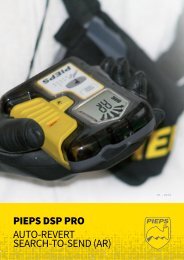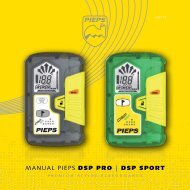LVS HintergrundwiSSen - pieps
LVS HintergrundwiSSen - pieps
LVS HintergrundwiSSen - pieps
Erfolgreiche ePaper selbst erstellen
Machen Sie aus Ihren PDF Publikationen ein blätterbares Flipbook mit unserer einzigartigen Google optimierten e-Paper Software.
NEW DEFINITION OF THE USEFUL<br />
RANGE USING A RELIABLE, ACCURATE,<br />
AND REPRODUCIBLE TEST PROCEDURE<br />
WITH PRACTICAL RELEVANCE –<br />
RUNNING A FIELD TEST TRACKED BY A DGPS<br />
Markus Eck,<br />
Michael Schober<br />
Pieps GmbH, Austria<br />
Marcellus Schreilechner<br />
Joanneum Research,<br />
Institute of Water<br />
Resources Management<br />
Hydrogeology &<br />
Geophysics, Austria<br />
ABSTRACT: We have used a Differential Global Positioning System (DGPS) for tracking the search trajectories<br />
of a rescuer at three different orientations of the antenna of a transmitted beacon. Hence, it is possible<br />
to determine the useful range of the width of search strips for different beacons. All commercially available<br />
(digital) beacons in Winter 2007/2008 were tested at a 50 x 50 m area in a field study. As examples three<br />
runs of two beacons with different antenna positions of the transmitter is presented. A buried transmitted<br />
beacon with a vertical orientation of the antenna represents the worst case scenario for determining the<br />
search strip width.<br />
KEYWORDS: Avalanche beacon; Useful range; DGPS; Field study; Coupling position; Search strip width<br />
1. INTRODUCTION<br />
In February 2006, the French ANENA (Association Nationale pour l‘Etude de la Neige et des Avalanches) started a<br />
discussion about the value of the search strip width and about the so-called “Useful Range”. This was the beginning<br />
of a still ongoing discussion with several organizations involved. In autumn 2006 the ICAR started the discussion<br />
about “how to find a common procedure to determine the search strip width”. In February 2007 Chris Semmel<br />
(DAV Sicherheitsforschung; Munich) publicized his statement and results, based on the measurements of the minimum<br />
receiving range. Also in February 2007 Juerg Schweizer (SLF; Davos) started his analysis (initiated by the ICAR)<br />
about “Determining the search strip width based on range measurements” and presented the result at the ICAR<br />
meeting 2007 in Pontresina (CH).<br />
Till now, no consensus exists about which of the existing measuring and analysis methods is the most practical.<br />
2. BACKGROUND<br />
The worst case scenario in the case of a slab avalanche is, when your partner is buried totally and you start<br />
your companion rescue without a receiving signal on your beacon. To search for the first signal as a single<br />
rescue person, the rescuer has to cover the avalanche<br />
field with meander shaped tracks until he<br />
gets the first detecting. If there are more than<br />
one rescue person are around to help, they safe<br />
time in going down the slab in parallel tracks.<br />
Doing this, each rescuer has to maintain the<br />
maximum search strip width (distance between<br />
the tracks of the rescuer/s) of his beacon.<br />
Picture 1: Single rescue person and multiple rescue people<br />
Autoren & Adressen<br />
Corresponding author address: Markus Eck, Pieps GmbH, Austria; Tel: +43 3182 52556-14; fax: +43 3182 52556-19; email: eck.markus@<strong>pieps</strong>.com<br />
PREMIUM ALPINE PERFORMANCE 25





